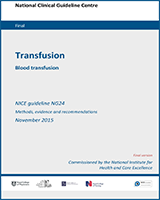From: 6, Alternatives to blood transfusion for patients having surgery: Cell salvage and tranexamic acid

Blood Transfusion.
NICE Guideline, No. 24.
National Clinical Guideline Centre (UK).
London: National Institute for Health and Care Excellence (NICE); 2015 Nov.
Copyright © 2015 National Clinical Guideline Centre.
NCBI Bookshelf. A service of the National Library of Medicine, National Institutes of Health.